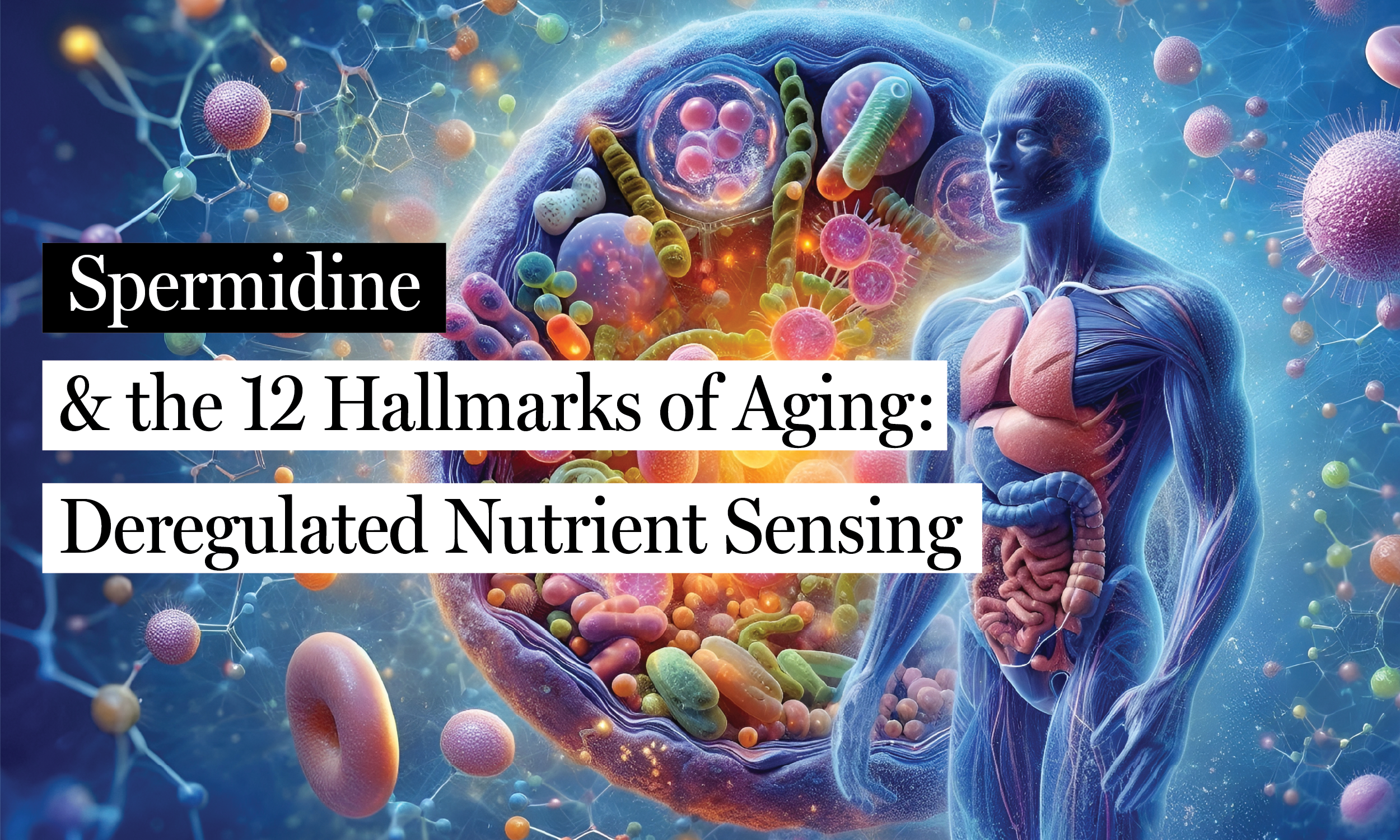
As we continue exploring the 12 hallmarks of aging, we turn our attention to the sixth: Deregulated Nutrient Sensing. This hallmark reflects how aging cells lose their ability to correctly interpret and respond to nutrient availability. Central metabolic pathways that once tightly regulated energy intake and cellular maintenance begin to falter, leading to dysfunction and age-related diseases. But research shows that spermidine, a naturally occurring polyamine, can help restore metabolic balance by modulating key nutrient-sensing pathways. Let’s take a closer look.
Understanding nutrient sensing: what it is and why it fails with age
For both cells and the entire body to function properly, they must be able to constantly monitor and respond to their nutrient and energy levels, just like a smart thermostat needs to constantly monitor the temperature to keep your house comfortable. Without these internal sensors and regulators, a cell would either stall out from energy depletion or overheat from overactivity.
Cells use a network of "master regulators" to keep track of these internal conditions and allocate resources accordingly. Think of these as the executive team running a company:
- mTORC1 (mechanistic Target of Rapamycin) acts like the operations manager, turning on the machinery for protein production and growth when nutrients, especially amino acids, are abundant.
- AMPK (AMP-activated protein kinase) is the chief financial officer, tightening budgets and shifting into "savings mode" when energy is low. It is activated during energy stress, promoting repair and catabolism.
- Sirtuins (especially SIRT1), which depend on NAD+, are like internal auditors, they monitor stress and damage, helping ensure long-term sustainability and efficiency.
- Insulin/IGF-1 signaling (IIS) are like the head of growth and development and push the company to expand when there are plenty of resources. They are central to growth and glucose homeostasis.
As we age, this finely tuned system begins to fall out of balance, like a company where the growth department is pushing for expansion even during a financial downturn. IGF-1 and mTORC1 stay too active, encouraging unnecessary growth and overconsumption, while AMPK and sirtuins become less responsive, and insulin sensitivity declines. This shift sets the stage for chronic inflammation and metabolic disorders, which contribute to poor energy conservation, reduced repair capacity, and less resilience to stress. This deregulated nutrient sensing contributes to many other hallmarks of aging including DNA damage, mitochondrial dysfunction and chronic inflammation.
On the bright side, research shows that inhibiting the growth-pushing IGF-1/mTORC1 pathways, or activating the low-energy guardians like AMPK and sirtuins, can tip the balance back toward health and longevity. It’s like shifting from a reckless spending mode to a smart, lean business strategy, cutting back unnecessary costs, reinvesting in infrastructure, and preparing for long-term success.
Certain interventions like fasting, caloric restriction, exercise, and compounds like spermidine, resveratrol, rapamycin or metformin can help rewire this nutrient-sensing circuitry. They tell the body: "Now’s not the time to grow, it’s time to clean up, conserve energy, and future-proof the system." Among these, spermidine stands out as the natural, efficient and safer option to restore nutrient sensing and promote healthy aging. There’s a lot of exciting research behind this, so let’s dig in and savor the science!
How spermidine supports healthy aging by regulating nutrient sensing
Spermidine’s ability to promote healthy aging stems from its multi-faceted influence on these critical nutrient-sensing pathways. By fine-tuning the balance between growth and repair signals, spermidine helps restore cellular homeostasis and resilience. Let’s explore the key ways spermidine acts on these pathways to support metabolic health and longevity:
Spermidine inhibits mTORC1
Spermidine promotes autophagy, the cell’s natural self-cleaning and recycling system, which is typically suppressed when mTORC1 is chronically active. In mouse models, dietary spermidine was shown to enhance autophagic flux and improve cardiac function, effectively mimicking the beneficial effects of caloric restriction (Eisenberg et al., Nature Medicine, 2016). Mechanistically, this autophagy induction is linked to the hypoacetylation of histone H3, driven by spermidine’s inhibition of EP300, a histone acetyltransferase that not only regulates gene expression but also influences mTOR signaling (Pietrocola et al., Cell Death & Differentiation, 2014). In mouse cardiomyocytes subjected to ischemia–reperfusion injury, spermidine reduced mTOR activity (it decreased p-mTOR, or the phosphorylated form of mTOR, which is a marker of its activation). This reduction in mTOR activity enhances autophagic flux, as mTOR is a key negative regulator of autophagy (Yan et al., British Journal of Pharmacology, 2019).
Spermidine activates AMPK
Spermidine increases AMPK phosphorylation (p-AMPK), the enzyme’s active form, particularly under nutrient stress. AMPK activation shifts the cell from energy-consuming processes to energy-producing ones, favoring fatty acid oxidation, autophagy, and mitochondrial biogenesis. In hepatocyte models, spermidine treatment led to increased AMPK activation and reduced lipogenesis, helping counteract features of metabolic syndrome (Gao et al., Cell Death & Disease, 2020). Another study also demonstrated that spermidine increases the p-AMPK in mouse cardiomyocytes. Western blot analysis confirmed that this enhanced AMPK activation is essential for spermidine’s cardioprotective effects, as it boosts autophagic flux and inhibits mTOR signaling. When the AMPK-specific inhibitor Compound C was used, phosphorylation was reduced and spermidine’s effects on autophagy were abolished, confirming that AMPK activation is a critical mediator of spermidine’s action (Yan et al., British Journal of Pharmacology, 2019). While AMPK activation typically occurs in response to cellular energy stress (such as an increased AMP/ATP ratio), the precise mechanism by which spermidine influences this pathway remains to be fully elucidated.
Spermidine enhances Sirtuin activity
SIRT1, a master regulator of metabolic homeostasis, benefits from the increased autophagic flux and mitochondrial health that spermidine promotes. A study demonstrates that spermidine inhibits vascular calcification in chronic kidney disease by upregulating SIRT1 and suppressing endoplasmic reticulum stress, offering a potential therapeutic strategy for vascular calcification (Liu et al, Aging Cell, 2021).
Spermidine improves insulin response
Spermidine supplementation in obese mice significantly improved their insulin sensitivity. It reduces hyperinsulinemia, improves glucose tolerance, and lowers the HOMA-IR index. These effects were associated with reduced inflammation, improved gut barrier integrity, and alterations in gut microbiota composition, which collectively contribute to better metabolic outcomes (Ma et al, Gut Microbes, 2020).
Final Food for Thought
Deregulated nutrient sensing is a major driver of aging and metabolic decline. As we grow older, our cells begin to misread cellular nutrient cues, disrupting critical pathways and accelerating the onset of age-related diseases. Fortunately, nature provides powerful tools to help recalibrate these internal signals, and spermidine is emerging as one of the most promising.
By inhibiting mTORC1, activating AMPK and sirtuins, and improving insulin sensitivity, spermidine helps re-tune the cell’s metabolic sensors and restore balance. In doing so, it supports cellular resilience, healthy aging, and protection against the metabolic dysregulation that often accompanies later life.
What makes spermidine especially exciting is its ability to mimic the effects of caloric restriction, long known to extend lifespan, without requiring strict fasting (see this article for a deeper dive into the link between spermidine and fasting). While more research is needed in humans, a growing body of evidence in preclinical models suggests that aging well isn’t only about what we cut out, but also about what we choose to include. And spermidine may just be the missing ingredient to your longevity recipe.
(Adapted from López-Otín et al., 2022)
Curious about the other hallmarks of aging and how spermidine can help combat them? Read more here.







